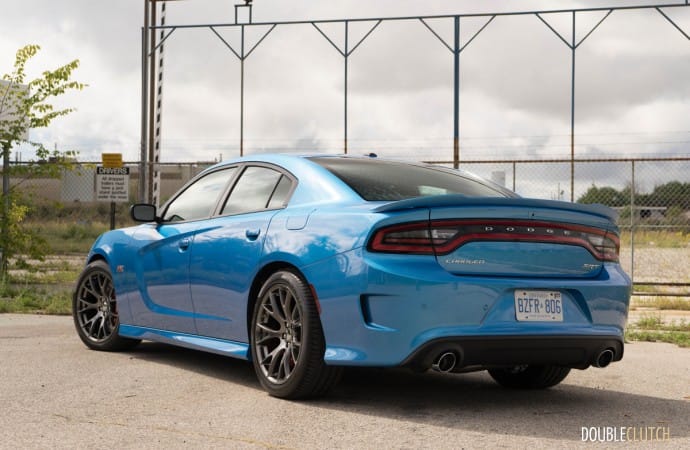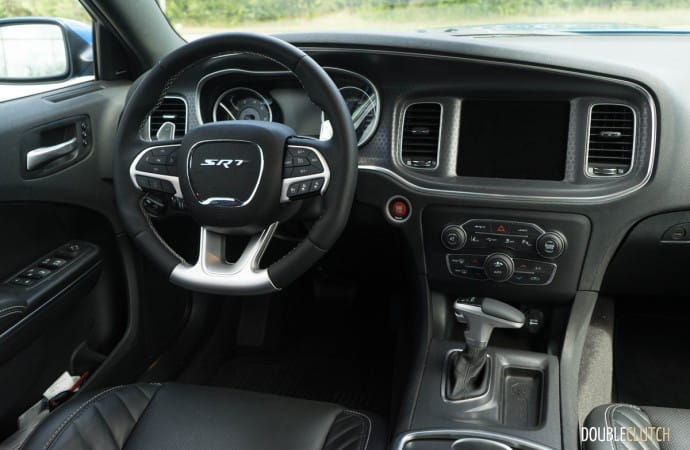When one wants to go fast in an American sedan – just like the good old days – the choices today are a little more limited than say, five to ten years ago. The Dodge Charger and Chrysler 300C (reviewed here) showed up to the scene with rear-wheel drive V8 power in the mid-2000s, and have consistently been strong sellers. General Motors brought the Holden Commodore over from Australia for 2008 and 2009 only as the Pontiac G8, just in time for the massive global recession, which caused both Pontiac and G8 to fall by the wayside. Today, the Charger and 300 are among two models that are left standing, and the G8 has since been replaced by the Chevrolet SS (reviewed here). Being that the DoubleClutch.ca team always enjoys any combination of eight cylinders and rear-wheel drive, there was absolutely no hesitation when Fiat Chrysler Canada offered up a B5 Blue Pearl 2017 Dodge Charger SRT 392 for a week on test.
Immediately after noticing the striking colour, one realizes that the Charger SRT 392 is a little more than the rental car you might drive when on a boring business trip. A rather large hood scoop complements a mesh grille up front, and the treatment carries through to the low-slung side skirts and a rear spoiler that’s almost like a ducktail. A set of gills adorns the corners of the rear bumper, and the dark finish 20-inch wheels wrapped in 275/40R20 rubber give the SRT 392 an unmistakable look. One catch – this styling treatment is practically the same as the 707-horsepower fire breathing flagship of the Charger lineup – the Hellcat. The SRT 392 doesn’t get the big boy engine, relatively speaking, so be prepared to sheepishly tell the truth when asked if your car is a Hellcat (reviewed here). Everybody will ask.
Although the Hellcat gets all the glory, the SRT 392 couldn’t be considered a slouch at all. With 6.4-litres of displacement out of the V8, peak horsepower is rated at 485, and there’s 475 lb-ft of twist to go along with it. It’s a cam-in-block, overhead valve configuration much like how muscle cars have always been, but refinement, drivability, and all the modern-day sensibility are retained. Throttle response from the naturally aspirated eight is excellent, thanks to the lack of things like turbos that introduce delays in air flow. The dual exhaust setup can only be described as loud; it’s easily as noisy, if not noisier than an aftermarket catback setup that a prospective buyer might end up with. Piping diameter is 2.75 inches, and there are no electronic cutouts or configurable noise levels. There’s only one way the Charger can be heard, and that’s turnt up to eleven.
Paired with the 6.4-litre V8 is the venerable eight-speed automatic built by ZF. The 8HP, as it’s called, delivers plenty of ratios to keep the engine in its powerband, without excessively hunting. When engaged in sport or track mode, the paddle shifters create a loud exhaust bark under upshift at higher rpm. It’s a very satisfying sound reminiscent of a proper dual-clutch gearbox, and only further adds to the crazy noises and acceleration afforded by the big V8.
The powertrain also features cylinder deactivation under light load, which can kill power to four cylinders when cruising on the highway. When active, there’s a slight exhaust drone generated due to the different engine acoustics; none of this noise appears when in V8 mode. Chrysler rates the SRT 392 Charger at 15.7 L/100km in the city, and an impressive 9.5 L/100km on the highway. While these numbers are realistic and can probably be matched when driving reasonably, observed test fuel economy was considerably worse, due to the constant need to hear the upshift pops and acceleration burbles. Depending on how much fun you have, your mileage may vary.
When it comes to driving dynamics, the Charger SRT 392 is configurable in many different modes. There’s an SRT button on the centre stack that brings up options for the transmission, suspension, traction control, and steering. Eco, Street, Sport, and Track are the different flavours one can select for each area of configuration. Having the shifter in regular Drive or Manual modes can call up two different configurations. In Drive, the Charger seemed to be happiest with the transmission in street mode and suspension in sport mode. When slapping the shifter over to Manual mode, having the transmission in track mode produced the most smiles per gallon, especially when using the paddle shifters. Steering is best kept in track mode at all times, which gives the wheel a decent amount of firmness.
Sadly, feedback and road feel is kept fairly isolated from the driver, and only serves to remind you that you’re in a large family sedan. Having the suspension in track mode creates an overly harsh ride, without greatly improving the handling over the softer modes. The overall driving dynamics of the Charger are to be expected of a car of its size and weight; the chassis responds eagerly to driver input, but the extra mass of the car makes itself immediately apparent. You will not win an autocross or handling competition in the Charger, but you will still find it to be competent and fun.
With the interior, the SRT 392 isn’t too far different from your standard issue Charger (reviewed here), save for features like the SRT button and the optional red seat belts. General interior room is a very strong point given the size of the car, which bodes well for taller or larger drivers and passengers alike. Seat comfort is above average, and will help when your 485 horsepower grocery getter is used for longer distance driving. The UConnect 8.4 multimedia suite is great to use, and is intuitive enough for most people to figure out fairly quickly. The interface is attractive to the eye, and is among the best in the business. The steering wheel is meaty and leather-wrapped, and inspires a good amount of confidence with its feel. Fit and finish of the interior – and the rest of the car, for that matter, is a bit of a letdown, as it’s more consistent with the base models costing half as much.
The below average fit and finish is exacerbated when considering the price of the SRT 392. Starting at $55,995, standard features include heated and ventilated front seats, huge six-piston front brakes, projector LED fog lamps, and bi-xenon HID projector headlamps. Options on the test vehicle include the $1,395 Technology Group, which includes blind spot monitoring, forward collision alerts, lane departure warnings, and adaptive cruise control. $1,500 adds a Harmon/Kardon audio system, which gives a good amount of bump, but lacks slightly in audio clarity. The red seatbelts are a $125 option, and the 275/40R20 Pirelli PZero summer tires add $445. With an as-tested price of $59,460, you certainly get a lot of powertrain and performance for your money, but the interior quality isn’t quite appropriate for this price range.
Bottom line – if you’re looking for a fast, cool sounding, cool looking sedan that offers plenty of space in both the interior and the trunk, the 392 is certainly worth looking at. When comparing base prices, it’s cheaper than the 707-horsepower Hellcat by almost $24,000. That’s quite a chunk of change, and one might argue that the Hellcat may not be worth it unless you absolutely have to have the extra power. Especially when finished in the B5 Blue Pearl paint, the 2017 Dodge Charger SRT 392 rounds itself out as a real head turner with gobs of power and solid performance to boot. For those looking for a muscle car that can be had new today off the showroom floor, the reasonably small set of shortcomings are generally outweighed by the strong sense of charm provided a big engine and loud exhaust. In other words, if you like hooning, the Charger SRT 392 is likely good for you.





































































